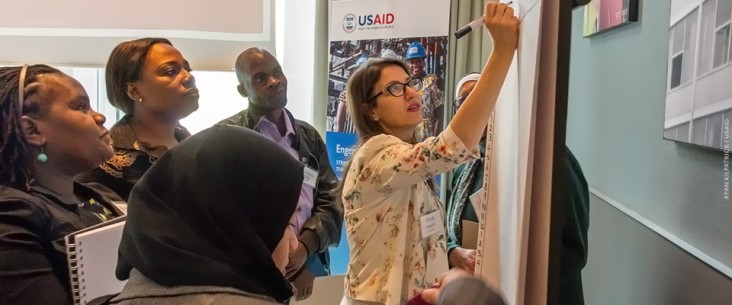Georgetown McDonough and USAID Expand Gender Equity Program
In 2019, the Gender Equity Executive Leadership Program serves over 50 participants from 17 utilities in 14 countries. Read the story
You are viewing:
Information released online before January, 2021.
Note: Content in this archive site is NOT UPDATED, and external links may not function. External links to other Internet sites should not be construed as an endorsement of the views contained therein.
You are entering the 2017-2020 Archive for the
United States Agency for International Development web site.
If you are looking for current information, visit www.usaid.gov.

Developed by USAID and Georgetown University McDonough School of Business, the program delivers a best-in-class curriculum empowering key decision-makers to effectively integrate gender equality initiatives across their corporate structure.
USAID’s Engendering Utilities program supports organizations in male-dominated industries to increase gender equality in the workplace. The Gender Equity Executive Leadership Program is a key component in USAID’s approach, as it builds the capacity of organizational leaders to identify critical gender equality gaps and implement interventions that directly increase opportunities for women within the company. The Gender Equity Executive Leadership Program also complements the work of Engendering Utilities' change management coaches, who employ proven tools and a customized best practices frameworkto help partner organizations introduce gender equality initiatives at each phase of the employee life cycle.
“The program has changed my perception of various aspects of my job as head of organizational development, which includes policy formulation, recruitment, and manpower planning. I have learned to consider gender equity in all aspects.”
– Osinubi Oyinlola, Eko Electricity Distribution Company, Nigeria
The Gender Equity Executive Leadership Program, developed by USAID and Georgetown University McDonough School of Business, delivers a best-in-class curriculum that spans the breadth of the employee life cycle. The course empowers the employees of partner organizations—including administrators, operational area managers, and other key decision-makers at all levels—to effectively integrate gender equality initiatives within their corporate structure.
In 2019, the Gender Equity Executive Leadership Program serves over 50 participants from 17 utilities in 14 countries. Read the story
In 2018, the first delivery of the leadership program included 21 participants from five countries. Read the case study
The program’s courses are taught in-person and virtually over 12 months by Georgetown University professors to three mid- to senior-level managers from human resources, operations, and other departments. Participants from each organization are carefully selected through a recruitment process conducted by USAID’s Engendering Utilities experts, in coordination with organizational leadership. The aim of the program is to train key decision-makers in partner organizations on how to implement gender equity-focused policies and practices.
Delivered by USAID and Georgetown University
Month 1,
In-person
Months 2–9,
Online
Month 10,
In-person
Months 11–12,
In-country
Each program module teaches participants how to:
Throughout the course, instructors help participants strengthen their organizational strategy and change management skills, as well as communication and persuasion skills, so that upon graduation they are fully prepared to make the business case for gender equality to their executive leadership.
USAID complements the Gender Equity Executive Leadership Program instruction by pairing each partner organization with an expert change management and gender equality coach. The coach delivers tailored technical support to partner organizations as they work through the program to analyze gaps, design and implement interventions, and monitor their progress toward gender equality and strengthening business outcomes. Using a customized scorecard tool, participants and their dedicated coaches help organizations make strategic, data-driven decisions to prioritize gender equality interventions, and track the progress of these interventions and their impact on organizational performance.
Through the Gender Equity Executive Leadership Program structure, USAID is developing leaders with skills to advance gender equality in their organizations. The program actively harnesses this cadre of leaders by fostering their roles as mentors and speakers to others in their workplaces, communities, countries, and the energy and water sectors globally. To engage a Gender Equity Executive Leadership Program alumnus to address your event, organization, or group, contact one of our program managers listed below.
Comment
Make a general inquiry or suggest an improvement.